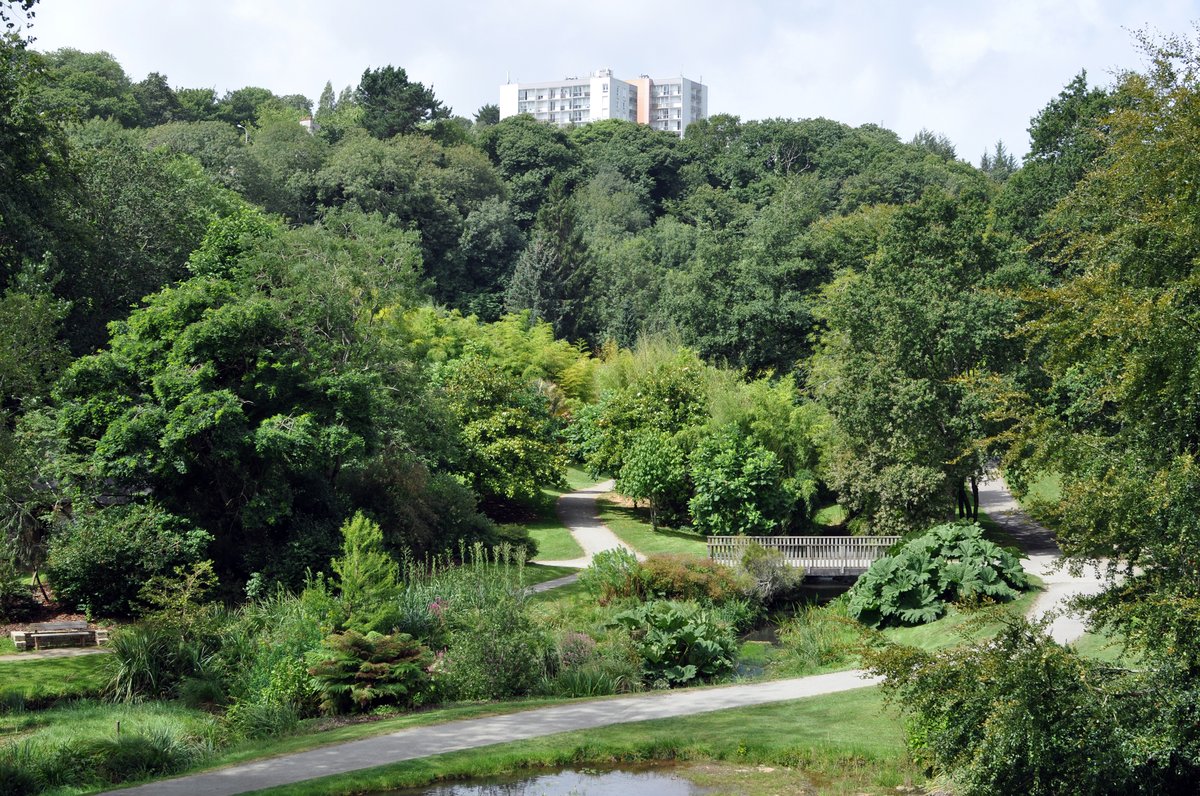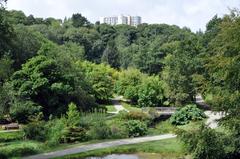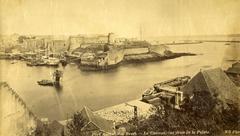
Comprehensive Guide to Visiting the National Botanical Conservatory of Brest
Date: 18/07/2024
Introduction
The National Botanical Conservatory of Brest is more than just a collection of plants; it is a living testament to the dedication of botanists and conservationists and the intertwined relationship between humans and the plant world. Nestled in the heart of Brest, this conservatory has become a key destination for those interested in botany, conservation, and the natural world. Established in 1971 under the guidance of Professor Jean-Yves Lesouëf, the garden was conceived as a sanctuary for endangered plant species at a time when the world was grappling with the alarming rate of plant extinctions. Brest, with its mild, humid climate influenced by the Atlantic Ocean, provided an ideal setting for such a diverse collection (Exploring the Garden National Botanical Conservatory of Brest).
From its inception, the conservatory adopted a global perspective, collaborating with institutions and individuals worldwide to conserve plant biodiversity. It quickly became a member of the Botanic Gardens Conservation International (BGCI), reflecting its commitment to global conservation efforts. Today, the garden houses plants from every continent except Antarctica, each meticulously labeled and telling a unique story of biodiversity and the importance of preservation (A Comprehensive Guide to Visiting the Jardin National Botanical Conservatory of Brest).
The National Botanical Conservatory of Brest is not just a scientific and educational institution but also a cultural landmark. It serves as an outdoor classroom for students of all ages, a research center for university students and researchers, and a tranquil escape for visitors seeking to reconnect with nature. This guide provides a comprehensive overview of the conservatory’s history, cultural significance, visiting hours, ticket information, major attractions, travel tips, and much more.
Table of Contents
- Introduction
- History and Cultural Significance
- Visitor Information
- Major Attractions and Collections
- Travel Tips and Nearby Attractions
- Special Events and Guided Tours
- Photographic Spots
- FAQ
- Conclusion
- References
History and Cultural Significance
Early Beginnings: A Haven for Endangered Plants
The garden’s story begins in the aftermath of World War II, a time of immense destruction and rebuilding. In 1971, facing the alarming rate of plant extinction worldwide, the idea for a botanical conservatory dedicated to the conservation of threatened species was born. This mission resonated deeply with Brest, a city that had itself been ravaged by war and understood the importance of resilience and renewal.
Professor Jean-Yves Lesouëf, a renowned botanist, spearheaded the project. His vision was clear: to create a sanctuary for endangered plants and a center for botanical research and education. The garden’s location in Brest, with its mild, humid climate influenced by the Atlantic Ocean, proved ideal for cultivating a diverse range of species, many of which were facing extinction in their natural habitats.
A Global Mission: Conservation Through Collaboration
From its inception, the National Botanical Conservatory of Brest adopted a global perspective. Recognizing that plant conservation transcended national borders, the garden actively collaborated with institutions and individuals worldwide. It became a member of the Botanic Gardens Conservation International (BGCI), a global network dedicated to saving plants from extinction.
This collaborative spirit is evident in the garden’s diverse collection, which includes plants from every continent except Antarctica. Each plant, meticulously labeled with its scientific name, origin, and conservation status, tells a story of biodiversity and the importance of preserving it.
Cultural Significance: More Than Just a Garden
The National Botanical Conservatory of Brest holds a special place in the hearts of the people of Brest and beyond. It is not merely a tourist attraction but a living museum, a research center, and an educational institution that plays a vital role in the community.
A Source of Pride and Inspiration: The garden stands as a symbol of Brest’s resilience and commitment to conservation. It is a source of pride for the local community, who view it as a testament to the city’s ability to overcome adversity and contribute to a global cause.
An Educational Resource: The garden serves as an outdoor classroom for people of all ages. Schoolchildren visit to learn about plant life, biodiversity, and the environment. University students and researchers conduct studies on plant conservation, propagation, and ecology.
A Place of Tranquility and Beauty: Beyond its scientific and educational value, the garden offers a serene escape from the hustle and bustle of city life. Visitors can wander through themed gardens, marvel at exotic blooms, and reconnect with nature.
Visitor Information
Visiting Hours
The National Botanical Conservatory of Brest is open year-round, with visiting hours typically from 9:00 AM to 6:00 PM. Please check the official website for the most up-to-date visiting hours.
Ticket Prices
Ticket prices vary depending on the season and special exhibitions. General admission is reasonably priced, with discounts available for students, seniors, and groups. Children under a certain age can enter for free. For precise ticket prices, visit the conservatory’s official website.
Accessibility
The conservatory is committed to being accessible to all visitors. There are wheelchair-accessible paths and facilities throughout the garden. For specific accessibility needs, please contact the conservatory in advance.
Major Attractions and Collections
The Conservatoire Botanique National de Brest
At the heart of the garden lies the Conservatoire Botanique National de Brest, a scientific institution dedicated to the conservation of endangered plant species. Established in 1975, the conservatory plays a crucial role in protecting threatened plants from around the world, focusing on those from Atlantic islands and the Massif armoricain. Visitors can learn about the conservatory’s vital work through exhibits and educational programs.
The Greenhouses
A visit to the conservatory is incomplete without exploring its remarkable greenhouses, which recreate the environmental conditions of different biomes:
- Tropical greenhouse: Step into a lush paradise filled with towering palms, vibrant orchids, and exotic fruits, highlighting the incredible biodiversity of rainforests.
- Temperate greenhouse: Journey through temperate regions, encountering ferns, camellias, and other plants adapted to milder climates.
- Arid greenhouse: Discover the fascinating adaptations of plants that thrive in arid environments, from cacti and succulents to drought-tolerant shrubs.
Thematic Gardens
Beyond the greenhouses, the conservatory features a variety of thematic gardens, each offering a unique perspective on the plant world:
- Mediterranean Garden: Explore a garden filled with fragrant herbs, colorful flowers, and iconic trees like olive and cypress.
- Japanese Garden: Find tranquility in the serene ambiance of the Japanese Garden, with its carefully raked gravel, stone lanterns, and meticulously pruned bonsai trees.
- Sensory Garden: Engage all your senses in the Sensory Garden, designed to stimulate sight, smell, touch, taste, and sound.
- Evolutionary Trail: Embark on a journey through time along the Evolutionary Trail, which traces the evolution of plants from their earliest forms to the present day.
Plant Collections
The conservatory boasts an impressive collection of plants from around the world, with a particular focus on endangered species:
- Endangered Plants: Learn about the threats facing these plants and the conservation efforts underway to protect them.
- Plants of the Massif armoricain: Discover the diverse plant life of the Massif armoricain, a region in western France known for its unique flora.
- Plants of Atlantic Islands: Explore the unique plant life of Atlantic islands, many of which are threatened by habitat loss and invasive species.
Travel Tips and Nearby Attractions
When visiting the National Botanical Conservatory of Brest, take some time to explore nearby attractions. The city of Brest offers a rich array of historical sites, museums, and scenic spots. Don’t miss the Brest Castle and the National Maritime Museum for a deeper dive into the region’s history.
Special Events and Guided Tours
The conservatory hosts special events and guided tours throughout the year. These events often focus on specific themes such as rare plants, conservation techniques, and seasonal blooms. Check the official website or contact the conservatory for a schedule of upcoming events and tours.
Photographic Spots
Photography enthusiasts will find numerous picturesque locations within the conservatory. From vibrant flower beds to tranquil water features, the garden provides endless opportunities for capturing stunning images. Remember to respect the plants and other visitors while taking photos.
FAQ
Q: What are the visiting hours for the National Botanical Conservatory of Brest?
A: The conservatory is typically open from 9:00 AM to 6:00 PM, but it’s best to check the official website for the most current information.
Q: How much are the tickets to the conservatory?
A: Ticket prices vary, with discounts available for students, seniors, and groups. Children under a certain age can enter for free. Please refer to the official website for detailed pricing.
Q: Is the conservatory accessible for visitors with disabilities?
A: Yes, the conservatory has wheelchair-accessible paths and facilities. For specific accessibility needs, it’s advisable to contact the conservatory in advance.
Q: Are there any special events or guided tours available?
A: Yes, the conservatory offers special events and guided tours throughout the year. Check the official website or contact the conservatory for the event schedule.
Conclusion
The National Botanical Conservatory of Brest stands as a beacon of plant conservation and a cherished cultural institution. Over the years, it has remained steadfast in its founding mission, actively participating in international conservation efforts, conducting crucial research, and educating the public about the significance of plant biodiversity. The conservatory’s diverse collections, stunning greenhouses, and thematic gardens offer an unforgettable experience for visitors of all ages, making it a must-visit destination for nature enthusiasts (Visiting the Garden National Botanical Conservatory of Brest).
As you explore the conservatory, you become part of its ongoing story, contributing to its legacy of conservation and experiencing the beauty and wonder of the plant world. The future of the conservatory is bright, with ongoing projects aimed at expanding its collection, developing new conservation strategies, and further engaging the community in its mission. Whether you are interested in plant conservation, seeking a peaceful retreat, or looking to explore Brest’s historical sites, the National Botanical Conservatory of Brest offers something for everyone. Plan your visit today and immerse yourself in the botanical wonders of this remarkable conservatory.
References
- Exploring the Garden National Botanical Conservatory of Brest, 2024, Author source url
- A Comprehensive Guide to Visiting the Jardin National Botanical Conservatory of Brest, 2024, Author source url
- Visiting the Garden National Botanical Conservatory of Brest, 2024, Author source url



















